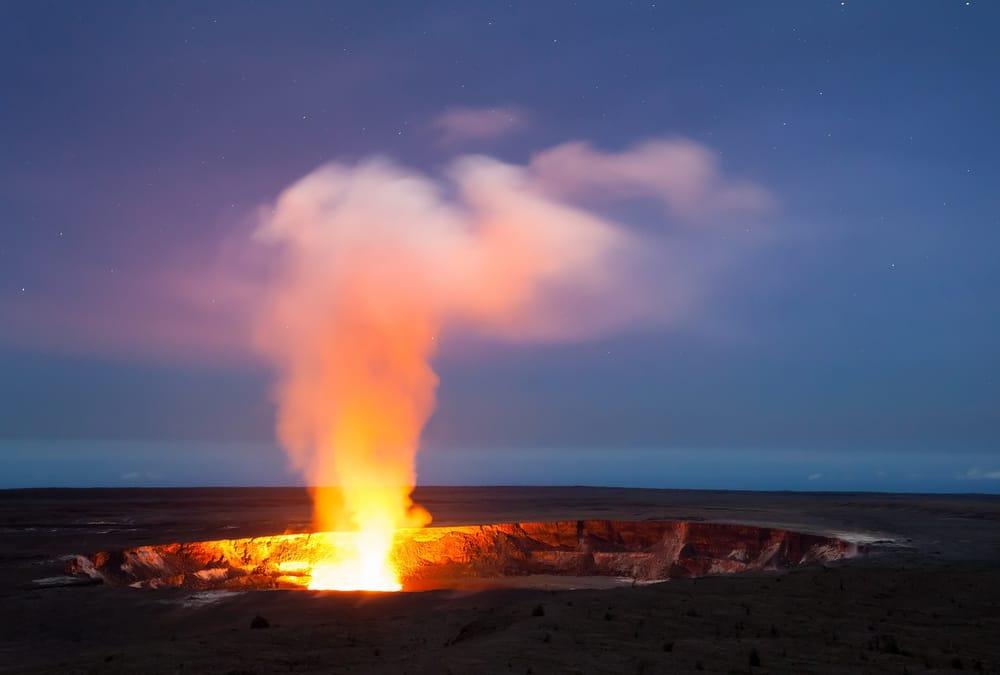Our very popular Deluxe Volcano Tour is the best way to get to see the eruption at Kilauea in safety and comfort. Big Island Video News on the proposed action plan after the 2018 eruption.
The on-again, off-again eruption at the summit of Kilauea volcano continues, as another pause in the lava effusion began on Friday morning. Before the pause, lava was overflowing the west vent within Halemaʻumaʻu, and filling the lava lake that occupies the western portion of the crater.
The current eruption began in September 2021. It is the second eruption to occur at the summit since it collapsed less than four years ago, and appears to be part of the greater geological cycle at the caldera, observed over many decades.
A National Park Service video shows the summit as the collapse sequence began, back in May 2018. The cloud of volcanic ash was created by rocks and debris falling into the receding lava lake, two days before Hawai‘i Volcanoes National Park was closed for 134 days. As the lava drained away from the summit, it erupted miles away on the lower East Rift Zone, inundating multiple neighborhoods in the district of Puna.
Inside the National Park, the seismic activity from the summit collapse significantly impacted buildings in the immediate vicinity of Uēkahuna Bluff, including the Jaggar Museum and the USGS Hawaiʻian Volcano Observatory facilities. The area of the overlook has been closed ever since.
Post-disaster assessments found that significant investment would be necessary to make the overlook buildings safe to occupy and operational. They are surrounded by fault lines and officials say the area continues to subside on the crater side, undermining slope stability at the existing terraces and building foundations.
This week, the National park service unveiled its proposal to repair and/or replace critical park infrastructure. We’ll examine the different components of the recovery plan in greater detail, but first an overview.
Under the proposed action, the National Park Service would demolish damaged structures at Uēkahuna Bluff and restore access to the existing overlook area next to the former Jaggar Museum. The Museum visitor center function would be replaced with a new building near the existing Kīlauea Visitor Center by the park entrance. The proposal would realign Crater Rim Drive near the park entrance and install a roundabout to improve safety. And, the plan will allow the USGS Hawaiʻian Volcano Observatory to construct a replacement field station adjacent to the ball field by Kilauea Military Camp in the park.
The National park Service provided a video simulation, showing an aerial overview of the project area, as it travels along Crater Rim Drive from Highway 11, past the entrance booths, to the proposed roundabout.
Park officials say the roundabout is needed due to increases in visitation over the past decade, as well as changes to circulation due to past eruptions that have led to traffic congestion problems.
Heading towards the summit, we pass the Kilauea Visitor Center, where a new visitor center building will be constructed that officials say will be compatible with the surrounding historic landscape.
Visitor parking will be expanded, and the proposal will provide a covered outdoor area for orientation, exhibits, and gathering space. Officials say they will seek to minimize impacts to site resources as much as possible.
Renderings depict the new visitor center building, which will replace the loss of the Jaggar Museum. It will be located next to the existing headquarters building. The existing building currently serves as the park headquarters, and a portion of the building is also used for a bookstore, a visitor center, and an auditorium. Upon construction of the new visitor center, the existing building would continue to serve as the park headquarters.
Beyond the visitor center, at the Kilauea Military Camp, a new building would be home to USGS research facilities. Officials say the new building would be nestled in among an existing grove of trees, between the military camp and an open grass area, which includes a historic ball field that becomes overflow parking during peak visitation.
Finally, we come to the Uēkahuna Bluff overlook and the site of the former Jaggar Museum, which will be demolished along with the other damaged facilities.
The National Park Service says it will incorporate historical reference to the Museum, with the building footprint delineated on the ground plane with stone salvaged from the building.
Officials plan to retain and repair the overlook wall, and expand the overlook area into the Jaggar Museum footprint. Large benches will serve as both seating and the opportunity for elevated viewing, and will incorporate salvaged stone from the Jaggar Museum. Post and cable barriers will delineate the limits of the overlook area.
The National Park Service is inviting the public to review the project details online, attend a virtual meeting on February 24th, and submit input before March 9.





